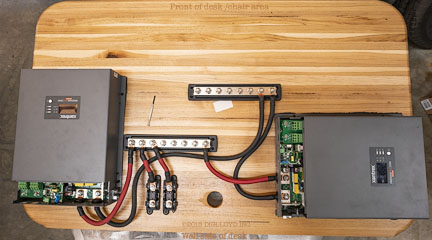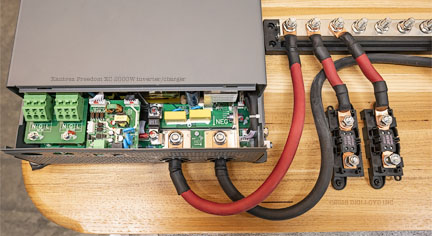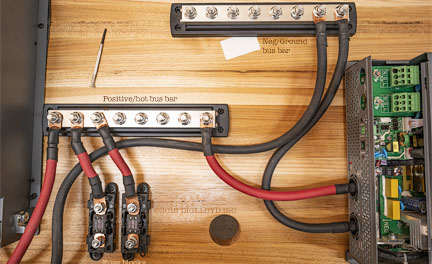
$220 SAVE $130 = 37.0% Western Digital 16.0TB Western Digital Ultrastar DC HC550 3.5-in… in Storage: Hard Drives
|

|

|

|

|
10 Kilowatt Lithium Battery System in Mercedes Sprinter: Introduction

Photographer and cyclist and Mac expert and software engineer Lloyd Chambers is available for consulting on general Sprinter considerations at his usual consulting rates via phone, or in person in the Palo Alto, CA area. Save yourself hours and mistakes by discussing issues up-front. More about Lloyd....
...
Before reading this multi-page how-to, the following pages provide important information about design and usage goals, battery performance, charging and so on.
- RV Batteries: Lithionics Lithium Batteries
- Planning for Voltage Losses from Cabling and Battery
- Xantrex Freedom XC Inverter/charger
- Mercedes Sprinter Alternator: Voltage, Amperage Under Real Loads at Idle, Charging Rate for Lithium Battery
- Mercedes Sprinter Alternator: Amperage Output with Real Loads, Voltage, Charging Rate for Lithium Battery
If you are already an expert (or think you are), caution is advised as some particulars are very important, and may differ from false premises promulgated on the internet. Thus I strongly advise reading the real-world testing pages above as to what actually happens.
10 kilowatts in dual batteries
I endorse ONLY the Lithionics batteries. In my research, I could find no other product with the level of quality offered by Lithionics longevity, safety, status monitoring and sub-freezing protection via internal circuitry, built-in BMS. I strongly recommend understanding a key point: saving money on a battery that seems similar may be a very poor value.
The 800-amp dual Lithionics lithium battery system in my Sprinter is the most capable battery system ever installed by ADF Sprinters (they do about 280 Sprinters a year). Or maybe ever installed in a Sprinter, period, but I certainly have no room for 3 or 4 such batteries!
I worked both with Lithionics engineering and ADF Sprinters to wire it as good as it can get in terms of proper electrical performance. Certain things have to be done right with dual batteries, or unequal current draw and charging become a problem. The initial dual-battery install suffered from unequal draw from the batteries. The final install solved this issue with a robust bus bar design.
Parts overview
In late March my 2017 Sprinter 4x4 van to ADF Sprinters to install a 48 X 29 inch hickory table, a key working space in my van, serving both as work desk and as the mounting platform for the dual Xantrex Freedom XC power inverters. The following parts were needed, which the following pages detail:
- Two (2) Lithionics 12V400A-5D-CTRL400 each with 5120 watt hours (usable around 4600 WH), dimensions 24.0 X 8.0 X 15.9, weighing 125 pounds each.
- For shore power charging: external 30 amp socket using heavy duty 8 AWG wiring to two interior AC sockets into which the inverts can independently plugged or unplugged.
- Two Xantrex Freedom XC 2000W inverter/charger units, each capable of inverting 2000 watts and charging at 80 amps, for a total of 160 amps of shore power charging capability.
- Two Blue Sea marine-grade 8-post 600A bus bars (one for positive/hot and one for ground), the focal point for all connections. These are 2.3 pounds bus bars, basically a thick chunk of tin-plated copper, very beefy high-grade stuff.
- Two Blue Sea Mega Amp 300A fuse blocks each with a 250-amp fuse between batteries and bus bar.
- Dual 1/0 cables from the stock alternator for charging when shore power is unavailable (most of the time, in my travel).
- Heavy duty welding cables throughout, 4/0 and 1/0 with appropriate lugs and high-quality hexagonal crimping.
- AC-out wall sockets, two from each inverter.
Shown below is partial wiring. The table is upside-down as shown, thus the top is the front of the table where one is seated. It was important to me to maintain the front portion of the table free and clear. This constrains the layout.
The hole in the rear of the table is for routing cables from gear on the table under the table. The table was custom made for me by Hardood-Lumber.com at very reasonable cost. I chose hickory for its outstanding strength and hardness and resilience, best of north American woods. The front and sides use a bullnose shape, very comfortable, and the corners use a 4-inch radius. The finish is acrylic urethane with a flat finish. The wood grain is highly attractive; I think the table is beautiful far beyond what one sees in most Sprinter interiors. It can support at least 500 pounds and is rock solid.
Continues below.

Obviously, most of the wiring cannot be done until the table is installed in the van. Key points:
- 1/0 cable from bus bar to inverters (as shown); this is ample given the very short cable length. Moreover, 4/0 lugs cannot fit into the rear of the inverter. It is *not* a concern that the cables from the bus bars to the inverters be of equal length as this does not alter the symmetry of the system as seen by the batteries. Each inverter draws from the common bus bar independent of the other. The load can be highly asymmetric (e.g., 2000 watts on one inverter, the other turned off!), and the batteries still see a common load.
- (not shown): one positive and one negative 4/0 cable from each battery to the corresponding bus bar, total of 4 cables. The positive cables must be of of equal length to each other. The negative cables must also be of equal length to each other. This maintains symmetry across the two batteries. The use of 4/0 keeps voltage losses low. We were able to keep cable length to 5 feet from the battery to the bus bar which is very good; 4/0 cable cannot just be bent into place.
- (not shown): dual grounding cables from negative bus bar to solid grounding points of van chassis. This is a closed-loop system as it has to be in a vehicle.
- The two fuse blocks are where the 4/0 positive/hot cables from the batteries connect. The choice of fuses can vary; I chose 250 amp fuses. The short cables from the fuse blocks then connect to the positive bus bar.

Below, two 8-post marine grade BlueSea bus bars, one positive/hot and one negative/ground.
Cables attached to the positive/hot bus bar:
- Two 1/0 cables, one to each inverter (short cable lengths make 4/0 unnecessary, plus 4/0 lugs won’t fit).
- Two 1/0 cables, one from each fuse block. Each fuse block is cabled via 4/0 to a battery, of equal length, not shown here.
- (not shown) Two 1/0 cables from alternator for charging via alternator (not shown: fuses and solenoids on separate panel).
- Two posts unused and available for future use.
Cables attached to the negative/ground bus bar:
- Two 1/0 cables, one to each inverter.
- Two 4/0 cables, one to each battery negative terminal, of equal length (!).
- Two 4/0 cables to two grounds on van chassis.
- Two posts unused and available for future use.

Simple in concept, but quite challenging in execution
Wiring dual inverters to dual batteries and dual bus bars and fuses using 4/0 cables in a confined space is no simple matter, unless one is willing to sacrifice interior space, which I did not: my usage constraints made it particularly challenging. Other interior configurations might be easier, such as in larger Sprinter vans with more available space and a different interior layout, but the amount of cabling with dual batteries and dual inverters requires careful planning.
A 144-inch wheelbase Sprinter leaves little room to place both batteries along with wiring and outlets. My solution after choosing battery placement was to bolt the fuses, bus bars and inverters underneath my sturdy 44 X 29 inch hickory table/desk (hickory is uniquely robust and very heavy/strong). There was no other place to install these items without losing critical space for my uses.
This installation proved challenging: while there is plenty of area on the 48 X 29 inch table, preserving legroom and storage space under the table near the front constrains placement. Also, bus bars require separation if fireworks are to be avoided, and all cables should be of minimal length to avoid voltage losses. It was a tricky business to pre-plan all cable routing, and in the end, those 4/0 cables are very thick and very unwieldy and must be matched in length as well! Do not underestimate just how challenging this is, even if one can lay out the parts in advance.
The dual Xantrex Freedom XC 2000W inverter/chargers were bolted on under the hickory table. Warning: hickory is very hard, so care is required to not break the screws. Sorbothane @AMAZON is used in many places (table, inverters, under batteries, etc) between contact surfaces to allow a little give on very rough roads.
Symmetry
The most important point of all: a high performance dual-battery system MUST use symmetric cabling. That is, equal-length positive and negative cables from each battery to the bus bars. In practice given my battery layout, one cable had to be coiled; allow for such considerations when planning cable routing—it can get tight.
From bus bars to the inverters, cables need not match—the key is symmetric cabling to/from the bus bars so that both batteries see the same load.
The prior installation rammed this point home, with differences in current draw between batteries, even though the wiring was heavy duty. If one battery drops to 10% SoC (state of charge) and shuts off while the other still has 30% SoC, the dual battery system is crippled in terms of its load capacity. That in fact is what happened in spite of heavy duty wiring with the initial wiring (prior to the use of bus bars).
Here is the cabling required:
- One 4/0 cable from positive terminal of each battery to 250 amp fuse box then to positive/hot bus bar, identical lengths for symmetry. We ended up keeping this cable length to only 5 feet. The voltage calculator shows that at 160 amps over one cable (320 amps total, peak transient load), the voltage drop should be 0.078V to the bus bar—impressive for a 320 amp load! The short ~1 foot 1/0 cable to the inverter would lose another 0.038V for a total voltage drop of 0.116V while the system carries 320 amps. For context, a 1500-watt household space heater draws about 140 amps at full power, which would mean only about 0.051V drop—extremely low. The Lithionics batteries maintain 12.6/12.7V under that load dropping down to about 12.2V at 90% discharge.
- One 4/0 cable from negative terminal of each battery to bus bar, identical lengths for symmetry.
- Dual 1/0 cables from alternator to bus bar (for charging).
- One 1/0 cable from positive bus bar to each inverter, equal length for symmetry (4/0 not needed for ~12 inch run, besides, 4/0 lugs won’t fit into the inverter).
- One 1/0 cable from negative bus bar to each inverter.
- Dual 4/0 grounding cables of equal length from chassis to negative/grounding bus bar.
That’s a LOT of cabling! It’s not as elegant as I would have liked, but the space constraints made it tough: the 4/0 welding cable cannot just be bent and forced into place. One has to plan out where excess cabling length will be looped or routed for example, since the cables between the hot and ground bus bars *must* be identical for symmetric performance. Thus one cable has to be coiled, complicating matters a bit more.
Shown below, 4/0 welding cable.

Seagate 22TB IronWolf Pro 7200 rpm SATA III 3.5" Internal NAS HDD (CMR)
SAVE $100



